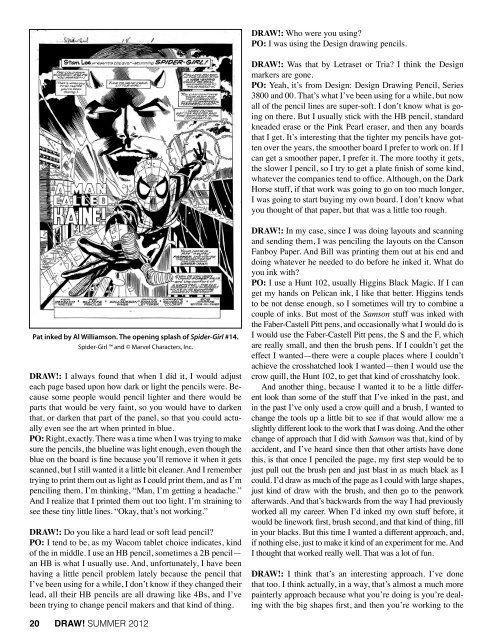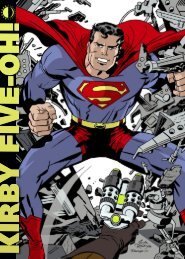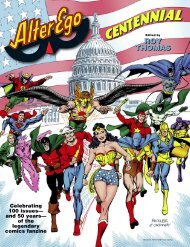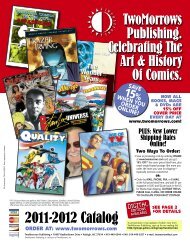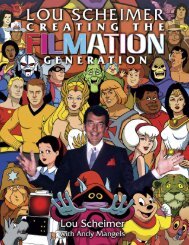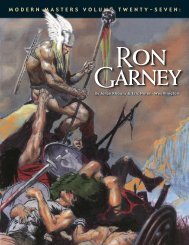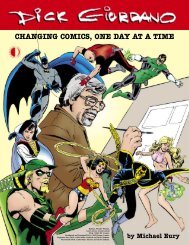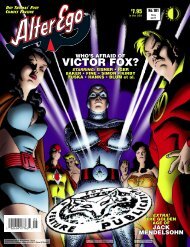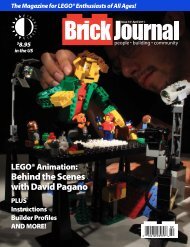Download - TwoMorrows
Download - TwoMorrows
Download - TwoMorrows
You also want an ePaper? Increase the reach of your titles
YUMPU automatically turns print PDFs into web optimized ePapers that Google loves.
DRAW!: Who were you using?<br />
PO: I was using the Design drawing pencils.<br />
DRAW!: Was that by Letraset or Tria? I think the Design<br />
markers are gone.<br />
PO: Yeah, it’s from Design: Design Drawing Pencil, Series<br />
3800 and 00. That’s what I’ve been using for a while, but now<br />
all of the pencil lines are super-soft. I don’t know what is going<br />
on there. But I usually stick with the HB pencil, standard<br />
kneaded erase or the Pink Pearl eraser, and then any boards<br />
that I get. It’s interesting that the tighter my pencils have gotten<br />
over the years, the smoother board I prefer to work on. If I<br />
can get a smoother paper, I prefer it. The more toothy it gets,<br />
the slower I pencil, so I try to get a plate finish of some kind,<br />
whatever the companies tend to office. Although, on the Dark<br />
Horse stuff, if that work was going to go on too much longer,<br />
I was going to start buying my own board. I don’t know what<br />
you thought of that paper, but that was a little too rough.<br />
Pat inked by Al Williamson. The opening splash of Spider-Girl #14.<br />
Spider-Girl and © Marvel Characters, Inc.<br />
DRAW!: I always found that when I did it, I would adjust<br />
each page based upon how dark or light the pencils were. Because<br />
some people would pencil lighter and there would be<br />
parts that would be very faint, so you would have to darken<br />
that, or darken that part of the panel, so that you could actually<br />
even see the art when printed in blue.<br />
PO: Right, exactly. There was a time when I was trying to make<br />
sure the pencils, the blueline was light enough, even though the<br />
blue on the board is fine because you’ll remove it when it gets<br />
scanned, but I still wanted it a little bit cleaner. And I remember<br />
trying to print them out as light as I could print them, and as I’m<br />
penciling them, I’m thinking, “Man, I’m getting a headache.”<br />
And I realize that I printed them out too light. I’m straining to<br />
see these tiny little lines. “Okay, that’s not working.”<br />
DRAW!: Do you like a hard lead or soft lead pencil?<br />
PO: I tend to be, as my Wacom tablet choice indicates, kind<br />
of the in middle. I use an HB pencil, sometimes a 2B pencil—<br />
an HB is what I usually use. And, unfortunately, I have been<br />
having a little pencil problem lately because the pencil that<br />
I’ve been using for a while, I don’t know if they changed their<br />
lead, all their HB pencils are all drawing like 4Bs, and I’ve<br />
been trying to change pencil makers and that kind of thing.<br />
DRAW!: In my case, since I was doing layouts and scanning<br />
and sending them, I was penciling the layouts on the Canson<br />
Fanboy Paper. And Bill was printing them out at his end and<br />
doing whatever he needed to do before he inked it. What do<br />
you ink with?<br />
PO: I use a Hunt 102, usually Higgins Black Magic. If I can<br />
get my hands on Pelican ink, I like that better. Higgins tends<br />
to be not dense enough, so I sometimes will try to combine a<br />
couple of inks. But most of the Samson stuff was inked with<br />
the Faber-Castell Pitt pens, and occasionally what I would do is<br />
I would use the Faber-Castell Pitt pens, the S and the F, which<br />
are really small, and then the brush pens. If I couldn’t get the<br />
effect I wanted—there were a couple places where I couldn’t<br />
achieve the crosshatched look I wanted—then I would use the<br />
crow quill, the Hunt 102, to get that kind of crosshatchy look.<br />
And another thing, because I wanted it to be a little different<br />
look than some of the stuff that I’ve inked in the past, and<br />
in the past I’ve only used a crow quill and a brush, I wanted to<br />
change the tools up a little bit to see if that would allow me a<br />
slightly different look to the work that I was doing. And the other<br />
change of approach that I did with Samson was that, kind of by<br />
accident, and I’ve heard since then that other artists have done<br />
this, is that once I penciled the page, my first step would be to<br />
just pull out the brush pen and just blast in as much black as I<br />
could. I’d draw as much of the page as I could with large shapes,<br />
just kind of draw with the brush, and then go to the penwork<br />
afterwards. And that’s backwards from the way I had previously<br />
worked all my career. When I’d inked my own stuff before, it<br />
would be linework first, brush second, and that kind of thing, fill<br />
in your blacks. But this time I wanted a different approach, and,<br />
if nothing else, just to make it kind of an experiment for me. And<br />
I thought that worked really well. That was a lot of fun.<br />
DRAW!: I think that’s an interesting approach. I’ve done<br />
that too. I think actually, in a way, that’s almost a much more<br />
painterly approach because what you’re doing is you’re dealing<br />
with the big shapes first, and then you’re working to the<br />
20 DRAW! SUMMER 2012


